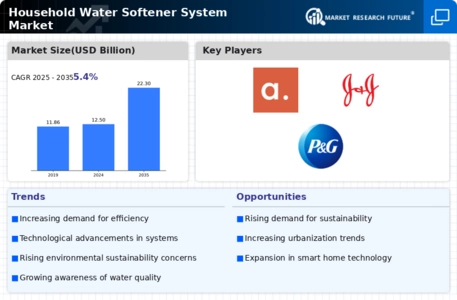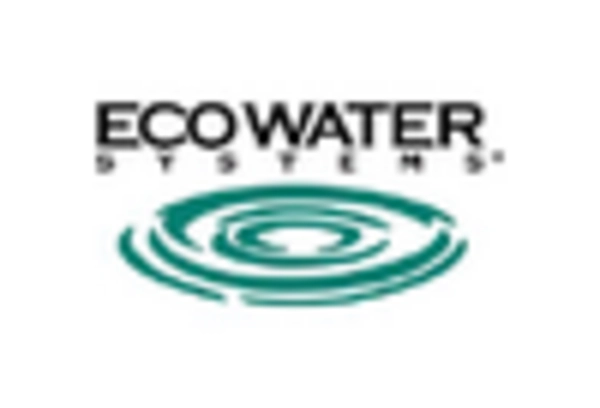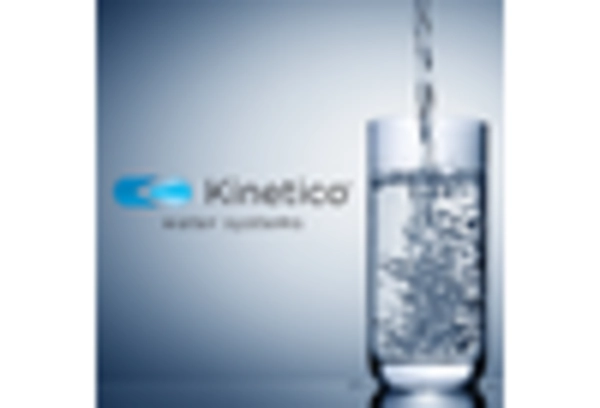Growing Home Improvement Trends
The Household Water Softener System Market is experiencing growth driven by the increasing trend of home improvement and renovation. As homeowners invest in enhancing their living spaces, they are also focusing on improving the quality of water in their homes. This trend is particularly evident in regions where hard water is prevalent, leading to a greater emphasis on installing water softening systems as part of home upgrades. Market data suggests that the home improvement sector is projected to grow significantly, which in turn is likely to boost the demand for household water softeners. As consumers seek to enhance their home environments, the integration of water softening solutions becomes a key consideration in their renovation plans.
Increasing Water Quality Concerns
The Household Water Softener System Market is experiencing a notable surge in demand due to rising concerns regarding water quality. Consumers are increasingly aware of the adverse effects of hard water, which can lead to scale buildup in plumbing and appliances, ultimately affecting their longevity and efficiency. Reports indicate that approximately 85% of households in certain regions encounter hard water issues, prompting a shift towards water softening solutions. This growing awareness is driving consumers to invest in household water softeners, as they seek to improve their water quality and protect their home infrastructure. As a result, the market is likely to expand, with manufacturers responding to this demand by offering innovative and efficient water softening systems.
Rising Demand for Sustainable Solutions
The Household Water Softener System Market is increasingly influenced by the rising demand for sustainable solutions. Consumers are becoming more environmentally conscious and are seeking products that minimize their ecological footprint. Water softeners that utilize eco-friendly technologies, such as salt-free systems or those that reduce water waste, are gaining popularity. Market analysis indicates that the demand for sustainable water treatment options is expected to grow, as consumers prioritize products that align with their values. This shift towards sustainability is prompting manufacturers to innovate and develop more environmentally friendly water softening solutions, thereby expanding their market reach and appealing to a broader audience.
Technological Advancements in Water Softening
Technological advancements play a pivotal role in shaping the Household Water Softener System Market. Innovations such as smart water softeners equipped with IoT capabilities are gaining traction among consumers. These systems allow for remote monitoring and control, enabling users to optimize their water usage and maintenance schedules. Furthermore, advancements in resin technology have led to more efficient ion exchange processes, reducing salt consumption and enhancing overall performance. Market data suggests that the integration of such technologies could lead to a significant increase in market penetration, as consumers are drawn to the convenience and efficiency offered by modern water softening solutions. This trend indicates a promising future for the industry as it adapts to evolving consumer preferences.
Regulatory Support for Water Quality Improvement
The Household Water Softener System Market is benefiting from increasing regulatory support aimed at improving water quality standards. Governments are implementing stricter regulations regarding water treatment and quality, which encourages households to adopt water softening systems. For instance, certain regions have introduced incentives for homeowners who install water treatment solutions, including softeners, to comply with new water quality mandates. This regulatory environment not only promotes the adoption of household water softeners but also fosters innovation within the industry as manufacturers strive to meet compliance requirements. As a result, the market is likely to witness sustained growth, driven by both consumer demand and regulatory frameworks that prioritize water quality.


















Leave a Comment